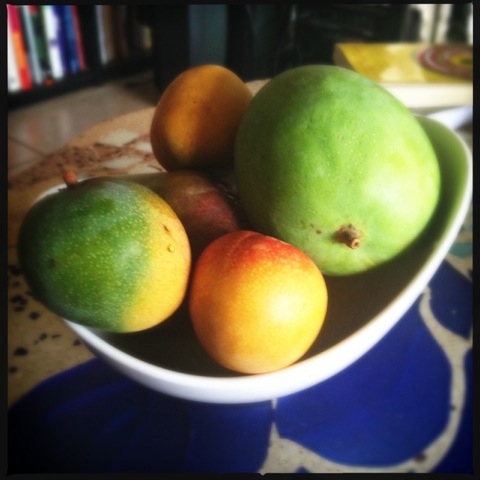6 Things You (Maybe) Didn’t Know About Mangoes
By Vanessa Wolf
It’s mango season here on Maui.
Available December through August, the fleshy golden fruit is causing branches to droop all over the island.
Whether piled in your fruit bowl or simply stinking it up under the sun and encouraging Mynah birds into a full, intoxicated swarm, they’re hard to avoid this time of year.
Whether you love them or hate them, here are six facts you may or may not know about the sweet fragrant fruit.
1. Papa was a rolling stone.
The over 1,000 known mango cultivars are derived from two strains of mango seed – monoembryonic (single embryo) and polyembryonic (multiple embryo). The monoembryonic hail from the Indian (original) strain of mango and the polyembryonic from the Indochinese.
2. They’re veritable chameleons.
There are over 400 varieties. The two varieties most widely available in the US are “Tommy Atkins” – with a dark red blush with green and orange-yellow accents, “Haden” – bright red with green and yellow overtones, ‘Kent’ – a green fruit with a red blush and a rich, sweet flavor and ‘Keitt’ – a green Mango with a less fibrous flesh and a mild, sweet flavor.
Don’t judge ripeness by color: some (like the Keitt) stay green when ripe. Rather, gently squeeze the ‘nose’ of the fruit. If there is slight give then the mango is ripe.
3. They are believed to be lucky.
The mango tree plays a sacred role in India.
It is a symbol of love and some believe that they can grant wishes. In the Hindu culture hanging fresh mango leaves outside the front door during Ponggol (Hindu New Year) and Deepavali is considered a blessing to the house. Mango leaves are used at weddings to ensure the couple bear plenty of children (though it is only the birth of the male child that is celebrated – again by hanging mango leaves outside the house).
4. They make for a really inadvisable camp fire.
Let’s get down to brass tacks: they’re considered toxic.
Burning mango wood, foilage and debris is not advised – toxic fumes can cause serious irritation to eyes and lungs.
Ouch.
5. They can mess you up.
The mango is a member of the Anachardiaceae family. Other distant relatives include the cashew, pistachio, Jamaica plum, poison ivy and poison oak.
“Distant relatives. Big whoop,” you say? Don’t be so hasty.
Turns out there is one thing this family has in common, and that’s a penchant for inflicting misery.
Dermatitis can result from contact with the resinous latex sap that drips from the stem end when mangos are harvested. This is a really mild-mannered way of stating what we’ve found to be true: Mango sap will have you scratching your skin down to the bone and brokering a deal with the devil.
Best bet? Wash up well with soap when you come into contact with the tree/sap.
6. And then they’ll nurse you back to health.
Don’t sign that contract with Lucifer too soon.
Over the centuries, every part of the mango has been proven beneficial and has been utilized in folk remedies in some form or another. Whether the bark, leaves, skin or pit; all have been concocted into various types of treatments or preventatives through the centuries. A partial list of the many medicinal properties and purported uses attributed to the mango tree are as follows: anti-viral, anti-parasitic, anti-septic, cough suppressant, anti-asthmatic, expectorant, contraceptive, aphrodisiac, hypotensive, laxative, and digestive aid.
However, we don’t know that it’s still considered such (or how to concoct any of these remedies), so perhaps just stay away from the bark, leaves, and sap and happy eating while the fruit is still plentiful.











